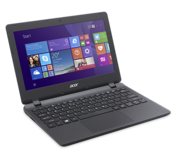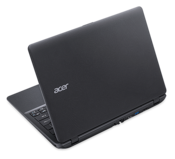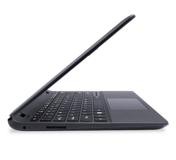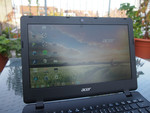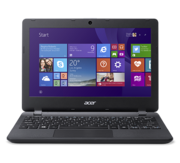Acer Aspire ES1-111-C56A Netbook Review

For the original German review, see here.
Netbooks are still big - in the truest sense of the word because they have grown over time. When looking back at the netbook pioneer, the first Eee PC, it was the smallest of its category with a screen size of just 7-inches. The screens in the successors and competition netbooks have grown quickly, though. The small, affordable laptops even challenged the big devices and proved that a Windows device does not have to weigh three kilograms.
The netbook-hype has long ebbed off. On the one hand, smartphones and tablets boomed, and on the other hand, the boundary between laptop and netbook faded at some point. Nevertheless, the small and affordable devices are not yet completely extinct and have found a right to exist in a niche. The modern netbook, such as the tested Acer Aspire ES1-111 here, usually features an 11.6-inch screen and has a resolution of 1366x768 pixels. The installed processing chip in our case is an Intel Celeron N2840. The little device is sold for below 250 Euros (~$310).
However, the buyer will have to waive quite a few things. For example, a high-capacity hard drive; the Aspire only sports a 32 GB flash storage. Netbooks do not have an optical drive from the outset. It also only has a very limited connectivity. However, the low price involves a lightweight and compact browsing machine and typewriter based on the latest and full-blown Windows OS.
Acer's netbook is also available with a 500 GB hard drive, for example as the Aspire E3-111. Other netbooks, such as Lenovo's S20-30, are also found in this price range.
Case & Connectivity
Acer's Aspire ES1-111 features black and matte plastic all over. The surface is adorned with a subtle pattern, which enhances the device's looks a bit. Although the surfaces are not glossy, they are susceptible to fingerprints, and the user will eternally be polishing the device.
As to build, we did not discover any flaws on the review sample. The compact design makes the netbook quite resistant to warping and locally applied pressure. Since there is no hard drive, the device is also less sensitive to shocks. It will not take damage right away when it is not handled with utmost care.
All interfaces are on the rear, which is rather unusual for a laptop. In addition to the power socket, there is one USB 2.0, USB 3.0, HDMI and Gigabit LAN port available. An SD-card reader is located on the device's left.
The Broadcomm BCM43142 module provides Wi-Fi in the current 802.11 b/g/n standards. The Wi-Fi connection always functioned reliably and presented an acceptable range. It worked impeccably across one story in the test.
Input Devices
The netbook features a basic chiclet keyboard, i.e. level, angular keys with an obvious gap - just like currently found in virtually every laptop. Although it features a pleasantly short drop, the pressure point cannot exactly be called clear or crisp. Typing feels a bit spongy and the user will automatically use a bit more force. Therefore, the keyboard is rather unsuitable for pleasant and swift typing. Furthermore, the keys are a bit wobbly, and the unit thus makes a slightly cheap impression. That is very noticeable when compared with a good desktop keyboard.
The touchpad has a different feel than the wrist rest surface - it is somewhat sleeker, which makes the difference well-discernible. The pad does not have dedicated mouse keys. Both lower corners, which have a crisp drop, can be used as an alternative for simple, short tapping. The sticker on the wrist rest's right touts a "Precision TouchPad," among other things. However, we cannot confirm that. Although multi-touch gestures functioned fairly well, other laptops have more reliable TouchPads.
Display
A premium-range screen cannot be expected in a netbook from this price range. So, a screen with a diagonal of 11.6-inches as well as only the minimum resolution of 1366x768 pixels is available. At least it is a matte screen and not a glare-type. That prevents annoying reflections to an extent. The Aspire netbook is even conditionally outdoor suitable with an average brightness of approximately 250 cd/m², providing it is a cloudy and not sunny day. The contrast ratio of 339:1 is not an exceptional rate, but it is also acceptable for a laptop from the low-cost price range.
| |||||||||||||||||||||||||
Brightness Distribution: 78 %
Center on Battery: 237 cd/m²
Contrast: 339:1 (Black: 0.74 cd/m²)
ΔE Color 9.61 | 0.5-29.43 Ø5
ΔE Greyscale 10.54 | 0.57-98 Ø5.3
40% AdobeRGB 1998 (Argyll 1.6.3 3D)
43.1% AdobeRGB 1998 (Argyll 2.2.0 3D)
62.5% sRGB (Argyll 2.2.0 3D)
41.7% Display P3 (Argyll 2.2.0 3D)
Gamma: 2.18
As to the quality of the colors, no subjectively serious drawbacks were discovered. The measurements using CalMAN, however, show clear shifts in color accuracy. The chronic bluish cast of many low-cost screens was also ascertained here. The viewing-angle stability also correlates to devices from this price range. The displayed image deviates quite soon horizontally, remains stable for a few degrees more vertically, but it also distorts in too wide angles.
Performance
Anyone who buys a netbook will hopefully not expect a performance miracle and should also be aware that the device is only meant as an office and browsing machine. However, these applications should run smoothly anyway. The spec sheet does not inevitably indicate otherwise. The hardware configuration, comprised of an Intel Celeron processor, 2 GB of RAM, and a flash storage, sounded solid at first.
Processor
Intel's Celeron N2840 is a dual-core processor that has been primarily designed for economic devices such as netbooks. In terms of performance, the Celeron lineup is located roughly between Atom and Pentium processors. With a TDP of only 7.5 watts, it has more been made for saving energy than for top performance. The CPU can clock with up to 2580 MHz, but both cores only run with a maximum of 2160 MHz in the Aspire ES1-111.
The Cinebench benchmarks show that the difference in the processor's performance is not vast compared with the competition. It was expected that Lenovo's S20-30 achieves virtually equal scores with its almost identical chip. Acer's Aspire E3-111 sports a quad-core Celeron that also achieves a twice as high score in the multi-core benchmark.
| Cinebench R11.5 | |
| CPU Single 64Bit (sort by value) | |
| Acer Aspire ES1-111-C56A | |
| Acer Aspire E3-111-C6LG | |
| Lenovo S20-30 | |
| CPU Multi 64Bit (sort by value) | |
| Acer Aspire ES1-111-C56A | |
| Acer Aspire E3-111-C6LG | |
| Lenovo S20-30 | |
System Performance
May demands be placed on the performance of a laptop from the lowest price range? Of course, because although the Aspire ES1-111 is not very powerful, it should be able to do what it promises, i.e. browsing and office tasks, at a tolerable speed. It does, according to our extremely subjective impression. The Intel Celeron is quite sufficient for that. The netbook's good scores in the PCMark benchmark comparison are likely due to the eMMC storage that presents slightly faster access times than the conventional hard drives in the contenders. We have to note here that the Aspire netbook is also available with a conventional hard drive.
| PCMark 7 Score | 2503 points | |
Help | ||
Storage Devices
A hard drive is not installed in our version of the Aspire netbook. Instead an eMMC flash storage with a capacity of only 32 GB is used. Unused data cannot be stored on the netbook because roughly two-thirds is reserved for the operating system. The user thus only has a few gigabytes of storage available. In contrast to a conventional hard drive, the small data chip has the advantage that it is lighter, cheaper, more compact, and slightly faster. It is, however, far remote from the data rates of a real SSD.
Graphics Card
The Intel HD Graphics (Bay Trail) graphics unit integrated into the Intel Celeron N2840 is principally DirectX 11 capable, but it will unlikely be able to render those kinds of applications (games) really smoothly. It is, however, quite apt for Full HD videos or office applications. It is just not possible to place any other demands on a netbook for below 250 Euros (~$310).
| 3DMark 11 Performance | 223 points | |
| 3DMark Ice Storm Standard Score | 12096 points | |
| 3DMark Cloud Gate Standard Score | 1057 points | |
Help | ||
| 3DMark 11 - 1280x720 Performance (sort by value) | |
| Acer Aspire ES1-111-C56A | |
| Acer Aspire E3-111-C6LG | |
| Lenovo S20-30 | |
Gaming Performance
Up-to-date games on a netbook are unthinkable from the outset. Demanding 3D graphics is simply not realistic in view of the performance. We nevertheless tested a somewhat older 3D title with Skyrim. It was not really playable with a single-digit frame rate. The game ran the start sequence with an average of 9 fps using the native resolution and minimum graphics settings. We could not record anything in our benchmark chart because every modification of the graphics settings caused the launcher to crash. Therefore, it is recommendable to only use casual games from the Windows Store on the Aspire netbook.
Emissions
System Noise
The netbook does not have any sources of noise, either in form of a fan or a hard drive. Thus, the Aspire ES1-111 operates absolutely noiselessly.
Temperature
The netbook does not get too warm despite its passive cooling. The device did not even reach 30 °C during routine use on the desk. The device's temperature also only climbed to approximately 40 °C in the stress test when the hardware was fully loaded. The CPU's behavior is also pleasing. It did not throttle its clock speed and ran with the full multiplier.
The Aspire E3-111 with a similar hard drive version as the netbook gets warmer. It reached a good 35 °C when idling, and peak rates of up to 50 °C were measured during full load. The temperature of Lenovo's S20-30 s is identical with the netbook we are testing here.
(+) The maximum temperature on the upper side is 39.1 °C / 102 F, compared to the average of 33.1 °C / 92 F, ranging from 21.6 to 53.2 °C for the class Netbook.
(±) The bottom heats up to a maximum of 42 °C / 108 F, compared to the average of 36.6 °C / 98 F
(+) In idle usage, the average temperature for the upper side is 27 °C / 81 F, compared to the device average of 29.8 °C / 86 F.
(+) The palmrests and touchpad are cooler than skin temperature with a maximum of 28.3 °C / 82.9 F and are therefore cool to the touch.
(±) The average temperature of the palmrest area of similar devices was 29.3 °C / 84.7 F (+1 °C / 1.8 F).
Speakers
Small openings for both speakers are on the underside. As expected, the sound is not really overwhelming simply for the lack of bass. Although the sound quality should suffice for playing an occasional video or podcast, users who have higher demands will inevitably have to use external active speakers.
Energy Management
Power Consumption
Intel's frugal chip scores in power consumption. The minimum consumption of 2.6 watts should pretty much be at the lowest end of the scale of the power required for running a laptop. The quad-core and hard-drive based Aspire E3-111 model consumes almost twice as much with 5 watts. That is also true for Lenovo's S20-30 with a very similar processor as in the Aspire ES1-111. Our device also presents the lowest maximum rate with only 11 watts.
| Off / Standby | |
| Idle | |
| Load |
|
Battery Runtime
While we only compared the minimum and maximum power consumption in the paragraph above, the frugal impression is put back into perspective because the average consumption in practical use will likely be roughly on par with the contenders. The battery life of five-and-a-half hours in our Wi-Fi test proves that. Lenovo's S20-30 also reached this runtime. The more energy-guzzling Aspire E3-111 shut down over an hour sooner.
Verdict
Acer's Aspire ES1-111 will certainly serve anyone looking for a lightweight, small, affordable, and quiet office or browsing machine well. Windows 8 runs reliably and smoothly on the little companion. It is still well equipped for Internet and desktop applications despite its low-end processor. Special demands on performance or connectivity should not be placed on the netbook, though. It is at most suitable as a secondary mobile computer with just 2 USB ports, low-capacity data storage of 32 GB, and at best mediocre battery life. However, we have to highlight the matte screen with its sufficient brightness.
Longer periods of work will not be joyous on the middling keyboard. A netbook, however, does not have to meet the claim of being apt for writing novels. Simple browsing, chatting or Skype on the couch - that's what the little Aspire E1-111 was made for, and it represents an affordable alternative for anyone who does not want to use a smartphone or tablet.


 Deutsch
Deutsch English
English Español
Español Français
Français Italiano
Italiano Nederlands
Nederlands Polski
Polski Português
Português Русский
Русский Türkçe
Türkçe Svenska
Svenska Chinese
Chinese Magyar
Magyar